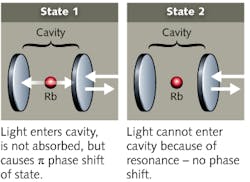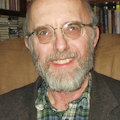
It's long been a given that detecting a photon inevitably destroys it, limiting the sensitivity of photodetectors and affecting what is possible in quantum computing and encryption. But now, Gerhard Rempe's group at the Max Planck Institute for Quantum Optics (Garching, Germany) has devised an ingenious way to detect photons without destroying them.
Their technique is based on interactions of a photon with a single rubidium atom optically trapped in the middle of a small, highly reflective optical cavity. The rubidium atom exists in a superposition of two ground states, which have different transition energies to an excited state. In state 1 (left), the atom is out of resonance with both the optical cavity and the incident photon, allowing the photon to enter the cavity, but not to interact with the atom, so it is reflected back out. In state 2 (right), the atom is resonant both with the cavity and with the incident photon, creating a strongly coupled system, but the photon cannot enter the cavity because it is resonant with it, and it is reflected away without entering.Although both superposed states reflect the photon, it has "left its trace on the atom," says lead author Andreas Reiserer. "The very moment the photon is reflected from the cavity, the resonant state experiences a phase shift relative to the off-resonance one. This phase shift can then be read out from the atom. In this way, the photon has survived its detection" without any change in its original properties, such as polarization.
It's an elegant experiment, which detected 74% of the incident photons, the group reports in Science Express. The atom response is easily detected, says co-author Stephan Ritter, adding that there is no fundamental limit to efficiency. Nonetheless, it is a proof-of-principle demonstration, far from a broadly applicable practical measurement technique.
Nonetheless, the experiment has potentially large implications because detection without destruction changes the rules. That could greatly improve photon detection efficiency at low photon flux. But its biggest impact could be on quantum computing. The authors write that their technique could lead to development of a deterministic quantum gate between a single photon and a single atom would could be extended to entangling the gate among several successive photons. It also might lead to loopholes in quantum encryption techniques that rely on photon destruction. Stay tuned for more adventures with Alice and Bob trying to elude Eve's efforts to eavesdrop on their communications.
About the Author
Jeff Hecht
Contributing Editor
Jeff Hecht is a regular contributing editor to Laser Focus World and has been covering the laser industry for 35 years. A prolific book author, Jeff's published works include “Understanding Fiber Optics,” “Understanding Lasers,” “The Laser Guidebook,” and “Beam Weapons: The Next Arms Race.” He also has written books on the histories of lasers and fiber optics, including “City of Light: The Story of Fiber Optics,” and “Beam: The Race to Make the Laser.” Find out more at jeffhecht.com.

